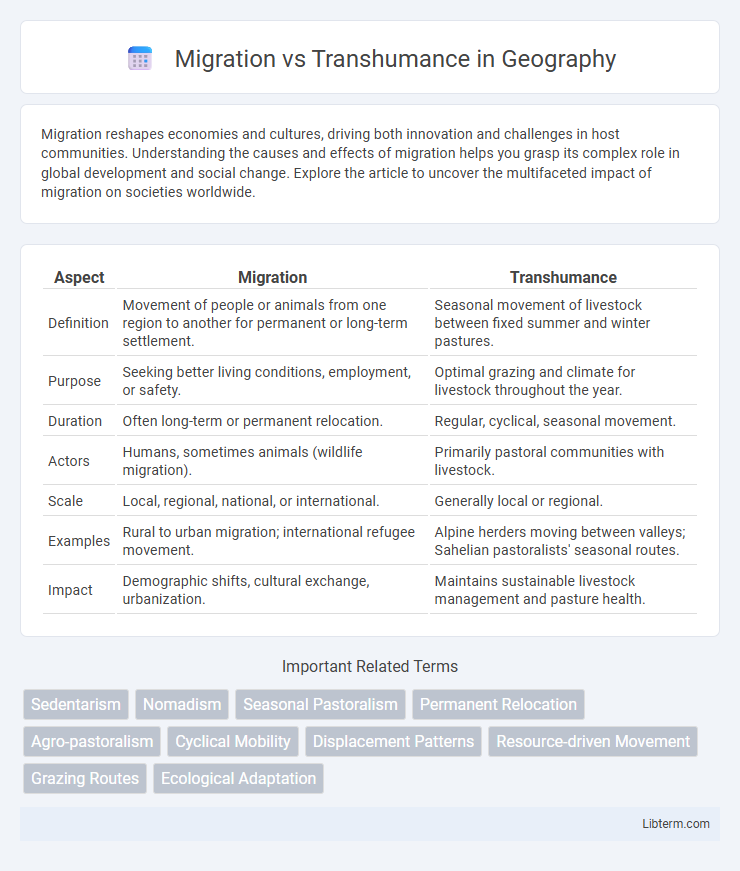Migration reshapes economies and cultures, driving both innovation and challenges in host communities. Understanding the causes and effects of migration helps you grasp its complex role in global development and social change. Explore the article to uncover the multifaceted impact of migration on societies worldwide.
Table of Comparison
| Aspect | Migration | Transhumance |
|---|---|---|
| Definition | Movement of people or animals from one region to another for permanent or long-term settlement. | Seasonal movement of livestock between fixed summer and winter pastures. |
| Purpose | Seeking better living conditions, employment, or safety. | Optimal grazing and climate for livestock throughout the year. |
| Duration | Often long-term or permanent relocation. | Regular, cyclical, seasonal movement. |
| Actors | Humans, sometimes animals (wildlife migration). | Primarily pastoral communities with livestock. |
| Scale | Local, regional, national, or international. | Generally local or regional. |
| Examples | Rural to urban migration; international refugee movement. | Alpine herders moving between valleys; Sahelian pastoralists' seasonal routes. |
| Impact | Demographic shifts, cultural exchange, urbanization. | Maintains sustainable livestock management and pasture health. |
Defining Migration
Migration refers to the large-scale, often seasonal or permanent movement of populations from one geographic region to another, driven by factors such as economic opportunities, environmental changes, or social conditions. Unlike transhumance, which involves the cyclical movement of herders and livestock between fixed seasonal pastures, migration encompasses broader demographic shifts including urbanization and international relocation. Key characteristics of migration include its scale, duration, and impact on both origin and destination areas, influencing cultural, economic, and ecological dynamics.
Understanding Transhumance
Transhumance is a form of seasonal livestock movement between fixed summer and winter pastures, primarily practiced in mountainous regions to optimize grazing resources. Unlike migration, which often involves permanent or long-distance relocation of people or animals, transhumance is cyclical and predictable, supporting sustainable agricultural practices and cultural traditions. This strategy enhances pastoral productivity by exploiting ecological variations in altitude and climate throughout the year.
Historical Contexts of Migration
Migration has historically involved large-scale, often permanent relocation of populations due to factors such as economic opportunities, wars, or environmental changes, shaping civilizations and nation-states over centuries. Transhumance, distinct from migration, refers to the seasonal movement of pastoral communities between fixed summer and winter pastures, maintaining long-established cultural and economic systems. Understanding these historical contexts highlights migration's role in urbanization and demographic shifts, while transhumance preserves traditional livestock management and ecological balance.
Origins and Practices of Transhumance
Transhumance originated in ancient pastoral societies as a seasonal livestock movement between fixed summer and winter pastures to optimize grazing resources and climate conditions. It involves regular, cyclical journeys typically over short distances within a defined territory, contrasting with migration's broader, often permanent relocation. Traditional transhumance practices persist in regions like the Alps, Himalayas, and Sahel, sustaining agro-pastoral livelihoods and preserving biodiversity through rotational grazing.
Key Differences Between Migration and Transhumance
Migration involves the long-distance, often seasonal movement of entire animal populations or human groups between distinct geographic regions, usually in response to environmental changes or resource availability. Transhumance refers to the regular, seasonal movement of livestock and herders between fixed summer and winter pastures within a localized area, emphasizing vertical or short-distance migration. Key differences include the scale of movement, with migration covering vast distances versus the localized routes of transhumance, and the focus of transhumance on livestock grazing patterns compared to broader ecological or climatic drivers in migration.
Environmental Factors Influencing Movement
Migration and transhumance are both seasonal movements influenced by environmental conditions, but they differ in scale and purpose. Migration involves large-scale, often long-distance travel prompted by changes such as temperature fluctuations, food availability, and breeding cycles, typically observed in animals like birds and wildebeests. Transhumance is a localized, cyclical movement primarily driven by pasture quality and water availability, common among pastoral communities and livestock in mountainous or arid regions.
Socioeconomic Impacts of Migration
Migration significantly influences socioeconomic structures by reshaping labor markets, enhancing income diversification, and facilitating knowledge transfer between regions. Remittances sent by migrants contribute to poverty reduction and improve access to education and healthcare in origin communities. Unlike transhumance, which primarily supports pastoral livelihoods through seasonal livestock movement, migration drives urbanization and economic development on a broader scale.
Cultural Significance of Transhumance
Transhumance holds profound cultural significance as it preserves traditional pastoral practices and strengthens community bonds through seasonal movements. This ancient practice influences social structures, rituals, and local knowledge systems, particularly in regions like the Mediterranean, Himalayas, and the Alps. Unlike migration, which often involves permanent relocation, transhumance embodies a cyclical way of life that sustains cultural heritage and environmental balance.
Modern Challenges and Adaptations
Migration and transhumance face modern challenges such as climate change, habitat fragmentation, and increased human encroachment, which disrupt traditional routes and access to grazing areas. Technological advancements like GPS tracking and mobile apps enable better management and monitoring of animal movements, facilitating adaptive strategies for herders and migrants. Policy interventions and community-based resource management play crucial roles in supporting sustainable practices and resilience in the face of environmental and socio-economic pressures.
Future Outlook for Migration and Transhumance
Future Outlook for Migration and Transhumance involves adapting to climate change impacts and evolving socio-economic conditions. Migration is projected to increase due to environmental pressures, urbanization, and economic disparities, while transhumance faces challenges from land degradation and policy restrictions but may benefit from sustainable rangeland management innovations. Advancements in technology and international cooperation are expected to shape more resilient and adaptive strategies for both human migration and traditional transhumance practices.
Migration Infographic

 libterm.com
libterm.com